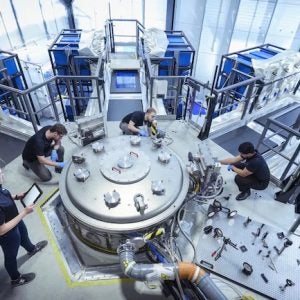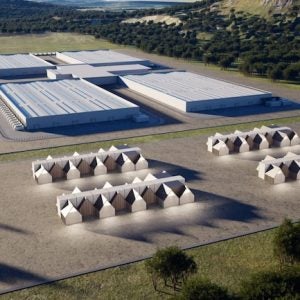 Hot tests have been completed at Ukraine’s ISF-2 dry used nuclear fuel storage facility constructed by Holtec International at the Chernobyl NPP site.
Hot tests have been completed at Ukraine’s ISF-2 dry used nuclear fuel storage facility constructed by Holtec International at the Chernobyl NPP site.
In April 2021, it is expected that the State Nuclear Regulatory Inspectorate of Ukraine (SNRIU) will issue a licence for operation of ISF-2 after reviewing and approving a safety analysis report, which will be prepared based on the results of hot tests.
During the operation of ChNPP from 1977 to 2000, more than 21,000 fuel assemblies accumulated at the station, which are now stored in the ISF-1 wet used fuel storage facility. ISF-1 is not designed for long-term storage of fuel, and its service life is limited and all the stored assemblies must be moved to ISF-2. The hot tests involved all the main and auxiliary technological systems of ISF-2 and the reporting documentation is being drawn up based on the test results.
During the tests, ChNPP personnel carried out all the work specified in the ISF-2 Commissioning Programme, namely:
- transportation of 22 transport canisters (CSP) with used fuel from ISF-1 to ISF-2;
- acceptance of 186 used fuel assemblies at ISF-2;
- fragmentation of 186 used fuel assemblies into fuel rod bundles and installation of 372 fuel cartridges with fuel rod bundles in two double-walled shielded canisters (DWCs);
- placement of two DWCs loaded with used fuel in concrete storage modules for long-term storage of up to 100 years;
- handling of solid radioactive waste of the "hot" chamber;and
- evaluation of the effectiveness of the biological protection structures.
US-based Holtec said on 14 December that a milestone had been reached with the loading the second DWC (a Holtec patented design) with RBMK used fuel into ISF-2. The first fully loaded DWC had been placed in storage on 18 November.
The two loaded DWCs, each containing a total of 93 used fuel assemblies from ISF-1 “marks the culmination of over two decades of effort”, Holtec said. The Interim Used Fuel Storage is the world’s most complex dry storage project with numerous unique aspects that were developed by Holtec to overcome the challenges that had previously delayed the project, the company noted.
Among the many innovative technologies are the use of DWCs to render any risk of leakage orders of magnitude more non-credible than required by regulations in the US and most regulatory regimes, and the deployment of a Forced Gas Dehydrator to extract the last trace of entrained moisture from the fuel for guaranteed storage safety. Each assembly is separated into three parts (two fuel bundles and an activated connecting rod) in a purpose-built hot cell (the world’s largest) before it is packaged in the double-walled transportable canisters (currently in use in the UK and Ukraine).
The transfer of ChNPP used nuclear fuel to a long-term safe dry storage at ISF-2 over the next ten years is one of key milestones in the transformation of the Chernobyl NPP into an ecologically safe system, said SNRIU Chairman Grigoriy Plachkov.
“This major milestone accomplishment for successfully loading the Two Canisters in the ISF-2 has been achieved by the hard work and diligent joint efforts of ChNPP, Holtec and its contractors,” said Volodymyr Peskov, ChNPP Acting General Director. He thanked international donors and the European Bank for Reconstruction and Development (EBRD) for their support.
“This major achievement entailed extensive processes, and collectively we worked together with technology and innovation to make this project an ongoing success,” said Holtec’s executive in charge of Ukraine Operations, Vice President Riaz Awan Awan. The loading by ChNPP was monitored by the International Atomic Energy Agency and SNRIU.
Holtec took over the ISF-2 project in 2011 after demonstrating to EBRD and SNRIU that it had the technologies to deal with Chernobyl’s RBMK fuel. The project had begun in 1998 but stalled when the technology provided by Areva was shown to be inadequate. Holtec took over the project and started work to develop a fully functional facility using the legacy systems, structures and components supplied by Areva, and by acquiring new replacement systems from France, Germany, Italy, the USA, and elsewhere.
ISF-2 cost €400 million ($474m) and was financed with contributions from Belgium, Canada, Denmark, the European Union, Finland, France, Germany, Italy, Japan, the Netherlands, Norway, Russia, Sweden, Switzerland, Ukraine, the UK and the USA.
Photo: First waste canister of spent fuel being loaded into ISF-2 in November (Credit: EBRD)






